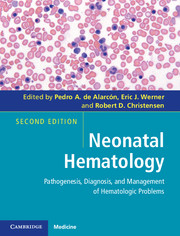Book contents
- Frontmatter
- Contents
- Contributors
- Foreword
- Preface
- 1 A historical review
- Section I Developmental hematology
- 2 Hematopoiesis
- 3 Development of the immune system
- Section II Erythrocyte disorders
- Section III Platelet disorders
- Section IV Leukocyte disorders
- Section V Immunologic disorders
- Section VI Hemostatic disorders
- Section VII Transfusional medicine
- Section VIII Miscellaneous
- Index
- Plate section
- References
3 - Development of the immune system
from Section I - Developmental hematology
Published online by Cambridge University Press: 05 February 2013
- Frontmatter
- Contents
- Contributors
- Foreword
- Preface
- 1 A historical review
- Section I Developmental hematology
- 2 Hematopoiesis
- 3 Development of the immune system
- Section II Erythrocyte disorders
- Section III Platelet disorders
- Section IV Leukocyte disorders
- Section V Immunologic disorders
- Section VI Hemostatic disorders
- Section VII Transfusional medicine
- Section VIII Miscellaneous
- Index
- Plate section
- References
Summary
Introduction
Susceptibility to infection is a significant cause of morbidity and mortality in neonates. Lack of a mature immune system is responsible for the increased vulnerability of neonates to infection. At the earliest stages of human development, the immune system consists of cells and molecules that are nonspecific in their action and do not have the ability to produce an amplified response with repeat exposure to pathogens (1). The cellular component of the immune system functions during the embryonic stage (first 8 weeks post-conception) and consists of macrophages, granulocytes, and NK cells. The adaptive immune system, consisting of T- and B-cells, begins to function by the second trimester, but is not at full capacity at birth. The adaptive immune system improves on the innate system by providing a response to pathogens which is quicker and more specific. Pathogen specificity is provided by receptors and antibodies that specifically recognize antigens. The adaptive immune system generates a large repertoire of receptors and antibodies by gene rearrangements. The lymphocytes of the adaptive immune system can also proliferate quickly following repeated antigen exposure. This proliferation is achieved through the clonal expansion of lymphocytes that have receptors to specific pathogens (2). This chapter will review how elements of the innate and adaptive immune system develop, how these elements function together as a whole, and will highlight specific immune deficiencies that are present in premature and term neonates.
- Type
- Chapter
- Information
- Neonatal HematologyPathogenesis, Diagnosis, and Management of Hematologic Problems, pp. 25 - 36Publisher: Cambridge University PressPrint publication year: 2013
References
- 1
- Cited by



